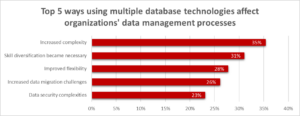
Multi-Database Shops Now the Norm, Redgate Says

The number of organizations adopting multiple databases went up by 17 percentage points over the past three years, increasing the complexity of data management and testing organizations’ capability to acquire the requisite skills to manage the databases effectively, according to new survey released by Redgate.
In 2020, 62% of the organizations surveyed by Redgate used two or more databases. By 2023, that number had increased to 79%, and 29% of them use five or more database, the company says in its State of the Database Landscape report, which it released today.
Redgate encountered 16 different databases among the 3,849 professionals it says took the company’s survey last year. The top databases were Oracle, SQL Server, MySQL, and Postgres, the company says.
The proliferation of multiple databases has various implications, including increasing the number and type of skills required to keep the databases well-maintained and running, Redgate says. Increased complexity was the number one impact of the jump in multi-database shops, according to the company’s survey, followed by skill diversification, flexibility, data migration, and data security concerns.
To handle this new multi-database trend, database administrators (DBAs) and developers must acquire new skills to manage and monitor the databases and keep costs in line, whether they’re running on-prem or in the cloud, said David Gummer, Redgate’s chief product officer.
“It’s clear that organizations are currently scrambling to keep up with increased complexity, the pressures of compliance and emerging technologies like AI and the cloud, and are seeking solutions to narrow the skills gap,” Gummer said in a press release.
The multi-database landscape is impacting organizations’ ability to implement and manage database changes as part of DevOps processes, according to Redgate, a British company that develops tools to streamline the incorporation of database changes as part of DevOps processes.
For starters, each database is different and has its own idiosyncrasies and quirks that DBAs and developers must account for, and developers also have their own style of development. That was the number one challenge for integrating database changes into DevOps cited by Redgate’s survey, cited by 31% of survey respondents.
“In effect, database professionals need to double their skillset to manage the range of database types that are now used by nearly 80% of all respondents in the survey,” Gummer said. “As an industry, we must work together and rise to the challenge of narrowing these skills gaps–whether that means upskilling internally or finding external solutions to address the needs across the database DevOps landscape.”
Redgate also noted that 88% of survey respondents report using the cloud in some capacity for their databases. However, many cloud implementations were sub-optimal, it said. One in five are using AI to manage their databases, while 35%) say they would like to, according to the report.
The other challenges cited in the Redgate survey results include synchronizing application and database changes (28%); preserving and protecting business critical data 21%); meeting security or compliance concerns (16%); and keeping up with the speed of delivery of applications (5%).
The pace of database change has accelerated, according to Redgate, which found that 30% of development teams now deploy database changes to production in a day or less. That is up from 15% in the 2021 survey, the company says.
Related Items:
The Polyglot Problem: Solving the Paradox of the ‘Right’ Database
Struggling Under Multiple Databases? Get Used To It
































